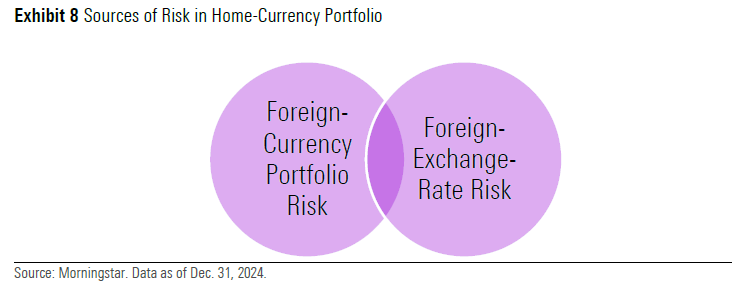The Takeaway
This research aims to explain the phenomenon wherein we observed a hedged-currency portfolio exhibiting higher volatility than an unhedged-currency portfolio.
Currency hedging should not be viewed as a direct mechanism to reduce the total portfolio risk. The purpose of hedging currency risk should be thought of as a process to ensure that the risk of the home-currency portfolio closely mimics the foreign-currency portfolio, by eliminating the impact on risk contributed by currency translations.
The unhedged home-currency portfolio experiences risk from three main sources: the inherent risk of the foreign-currency portfolio, the risk associated with forex-rate movements, and the risk resulting from the interaction between foreign-currency portfolio returns and forex-rate movements.
Currency hedging should not be viewed as a direct mechanism to reduce the total portfolio risk. While hedging foreign exchange (forex) risk aligns the risk profile of international investments with that of domestic portfolios, it does not always lower overall portfolio volatility. In some cases, hedging can inadvertently increase total portfolio risk. This occurs when a negative correlation exists between foreign asset returns and currency movements, as unhedged exposure can provide natural diversification benefits. However, this effect is not universal across all negatively correlated assets. This research establishes the mathematical conditions under which hedging forex risk may lead to higher total portfolio volatility, offering valuable insights for investors.

©2025 Morningstar. All Rights Reserved. The information, data, analyses and opinions contained herein (1) include the proprietary information of Morningstar, (2) may not be copied or redistributed, (3) do not constitute investment advice offered by Morningstar, (4) are provided solely for informational purposes and therefore are not an offer to buy or sell a security, and (5) are not warranted to be correct, complete or accurate. Morningstar has not given its consent to be deemed an "expert" under the federal Securities Act of 1933. Except as otherwise required by law, Morningstar is not responsible for any trading decisions, damages or other losses resulting from, or related to, this information, data, analyses or opinions or their use. References to specific securities or other investment options should not be considered an offer (as defined by the Securities and Exchange Act) to purchase or sell that specific investment. Past performance does not guarantee future results. Before making any investment decision, consider if the investment is suitable for you by referencing your own financial position, investment objectives, and risk profile. Always consult with your financial advisor before investing.
Indexes are unmanaged and not available for direct investment.
Morningstar indexes are created and maintained by Morningstar, Inc. Morningstar® is a registered trademark of Morningstar, Inc.
